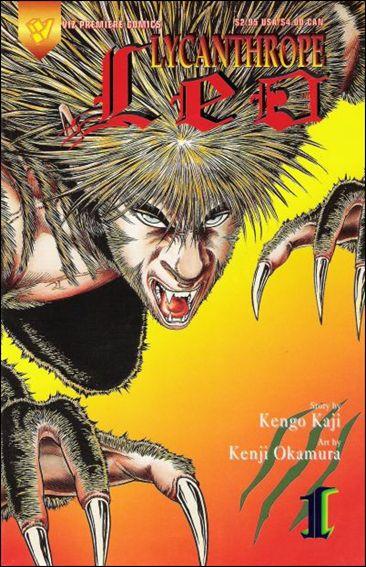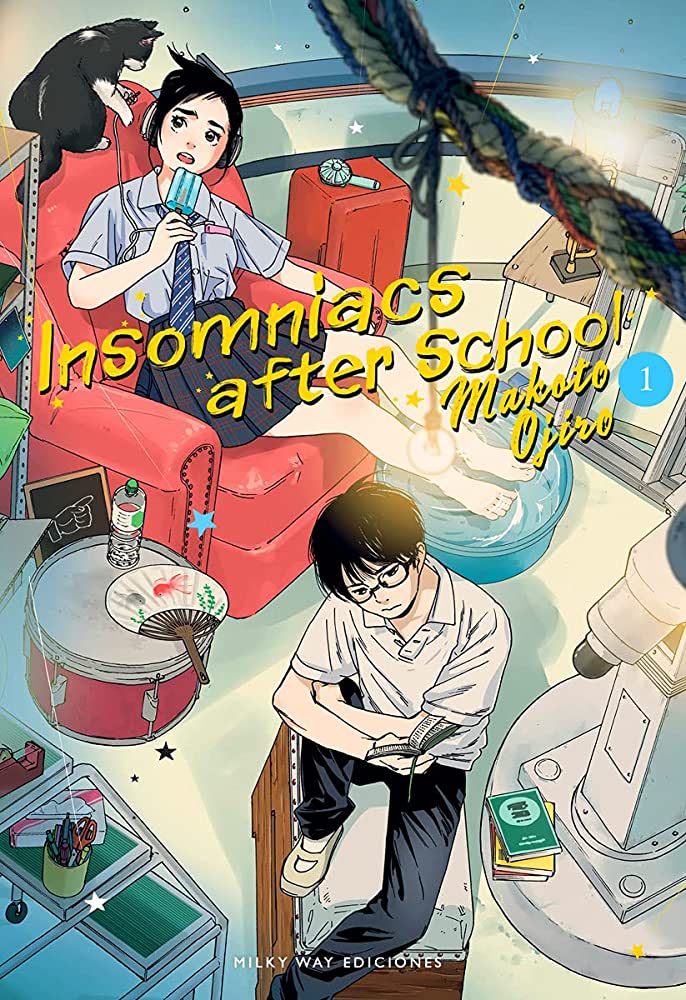Back in the 1980s and 1990s, before publishers realized that they could sell manga to teenagers through Borders and Books-A-Million, VIZ and Dark Horse actively courted the comic-store crowd with blood, bullets, and boobs. It was a golden age for manly-man manga — think Crying Freeman and Hotel Harbor View — but it was also a period in which publishers licensed some bad stuff. And when I say “bad stuff,” I mean it: I’m talking ham-fisted dialogue, eyeball-bending artwork, and kooky storylines that defy logic. Lycanthrope Leo (1997), an oddity from the VIZ catalog, is one such manga, a horror story with a plot that might best be described as Teen Wolf meets The Island of Dr. Moreau with a dash of WTF?!
The Leo of the title is Leo Takizawa, a high school student with a cute girlfriend and a gruff father. In the days leading up to his seventeenth birthday, he surprises his track teammates with an astonishing, world-record performance in the hundred-meter dash. Dad, noticing Leo’s dramatic transformation from speedy string-bean to Carl Lewis challenger, realizes that his worst fear is coming true: Leo is on the verge of turning into a lycanthrope, a powerful shape-shifter capable of rending a man limb from limb. So Dad does what all caring, self-respecting parents in his situation would do: he lures his son into an abandoned cabin in the woods, then attempts to shoot him with a fancy crossbow — but not before he gives a long, impassioned speech explaining what Leo is and why lycanthropes are mankind’s avowed enemy. Dad’s garrulousness proves his undoing; like so many villains, he spends too much time delivering an expository monologue and not enough time getting down to business, thus providing Leo opportunity to assume his true form and take Dad out with one blow of his werelion’s paw.
Yes, you read that right: Leo is a werelion. I admit the idea has potential; it liberates the author Kengo Kaji from the conventions of Western were-lore — the silver bullets and full moons and gypsies — while allowing him to milk the human/animal dichotomy for its full dramatic potential. Alas, Kaji extends the were-concept to other, less majestic animals for a subplot involving a centuries-old conflict between carnivore and herbivore lycanthropes. (The meat-eaters favor wiping out mankind; the cud-chewers prefer peaceable co-existence.) The nadir of the anything-is-more-awesome-in-were-form, however, is Mayuko Asuka, a sexy young teacher who turns out to be… a were-flying squirrel. And an evil were-flying squirrel, I might add, one who isn’t above seducing a seventeen-year-old or attacking a lycanthrope who threatens to reveal too much of the carnivores’ world-domination plans.
Kenji Okamura’s artwork is awe-inspiring and awful simultaneously. On the one hand, he draws amazingly detailed monsters, rendering their fur and claws and muscle-bound chests with exquisite care, even when they’re ripping each other to pieces; imagine Sylvester Stallone in werewolf drag, and you have some idea of what the male lycanthropes look like in their animal forms. On the other hand, Okamura’s human characters look like they belong in a Fernand Léger painting, with their plastic, impassive faces. Okamura struggles to convey emotion convincingly; about the best he can do is depict Leo sweating profusely. (By my count, Leo loses twenty to thirty pounds of water weight over the course of the first volume.) Worse still, Okamura frames almost every scene from an odd vantage point that distorts the characters’ anatomy, making them look ridiculously stumpy or leggy; I honestly thought Leo was being bullied by a midget in several scenes, thanks to the extreme angle at which we view Leo’s tormentor.
If you’re wondering why you haven’t heard more about Lycanthrope Leo, that’s because VIZ suspended production on the series after just one volume, citing poor sales. It’s not hard to imagine why Leo didn’t connect with American readers; the art has a throwback-to-the-eighties look, while the story is so preposterous and self-serious that it doesn’t work as straight horror or camp. From a reader’s standpoint, the most disappointing thing about Leo is the abruptness with which the English edition ends; Kaji introduces a key character in the final chapters of volume one, leaving readers to wonder whether the carnivores and herbivores eventually achieve detente. Of course, you probably won’t care if they do, considering all the sweaty, frantic silliness that precedes the introduction of the wise were-buffalo; for all the howling and “unsheathing of steel claws,” Lycanthrope Leo is about as scary as a kitten.
Manga Artifacts is a monthly feature exploring older, out-of-print manga published in the 1980s and 1990s. For a fuller description of the series’ purpose, see the inaugural column.
LYCANTHROPE LEO, VOL. 1 • STORY BY KENGO KAJI, ART BY KENJI OKAMURA • VIZ COMMUNICATIONS • 224 pp. • NO RATING (GRAPHIC VIOLENCE, NUDITY, STRONG LANGUAGE)




Serdar says:
All that’s missing is a Guin cameo.
Emilio says:
It’s funny. I don’t find this manga anywhere near as offensively bad as Crying Freeman, which you appear to hold in higher regard. Still, I do agree with your assessment of most of it’s weaknesses. I do sort of like the fact that it plays things the way it does as opposed to becoming something more campy or horrific. This manga reminded me of Guyver, a manga which also ultimately failed but lasted longer, probably owing to the fact it had an anime counterpart.
I also think the title and the covers prevented this thing from doing better. The alliteration of the title doesn’t work for something that isn’t campy or light-hearted, and the way that the cover artwork comes across makes the whole thing seem more like a set of 90’s Magic: The Gathering cards than a shonen manga. Maybe it’s the way it’s colored.
Keep up the good work! I dig Manga Artifacts.
Jade says:
Ughuh, that cover makes me gag. That creature looks like a wombat. I passed this up in a used book store about a year ago because that’s one of the worst covers I’ve ever seen on any comic. A voice in my head told me not to judge a book by its cover, but I said, No way, that’s not just a cover, that’s like wrapping a book in poopy toilet paper.
Otherwise if someone wanted to make a comic about a were-lion fighting really cool were-creatures, they can’t do that now because some idiot made a comic about a were-lion fighting squirrels and buffalo!
Katherine Dacey says:
@Serdar: Were-jaguars! Now that would be awesome.
@Emilio: I think you’re right about the title; the alliteration suggests something kind of campy or teen-oriented, rather than a straightforward horror title aimed at mature readers.
Glad to hear that someone is enjoying these manga time-trips! I’ll have to consider Guyver for a future column. Crying Freeman might be fun to revisit as well; it was one of the first manga I read, so I wasn’t as critical or particular about what I was reading then. I’d be curious to see if I enjoy it as much the second time around, or if it turns out to be too purple for me.
@Jade: Come to think of it, Leo does kind of resemble a wombat on the cover! Actually, all of covers for this series were terrible (it was originally released in floppy format), which probably contributed to its poor sales. (You can browse the full gallery at Anime Vice: http://www.animevice.com/lycanthrope-leo/15-960/) Sadly, the were-flying squirrel never gets her turn in the spotlight.
DeBT says:
I remember reading that Manga in the bookstore, and was disappointed that there wasn’t any more. Keep in mind that this was at a time when I was starving for anything Manga-related, and was reduced to buying lackluster series, such as Grey, and the rest of the Ninja Manga, Legend of Kamui after the first two volumes. (Legend of Kamui is a property that could easily appeal to the Lone Wolf & Cub crowd, though in one of the last letters to the editor, a fan who purchased the Japanese versions was surprised at how violent and rapist the series was) If there were any more volumes after this, I might’ve been inclined to purchase this series. I might’ve been on my way to being an addict, but I still had some standards.
I was thinking of this now-forgotten series when I wrote a summary of the first three volumes of another Lycanthropic Manga:
http://sundaycomicsdebt.blogspot.com/2010/08/twilight-for-guys.html
Katherine Dacey says:
@DeBT: I really enjoyed your essay on “Twilight for Guys,” and included a link to it in my round-up of reader submissions for the Worst Manga contest. That series sounded spectacularly, awesomely bad!
Jason Thompson says:
I’ve read all the way to the end of this series in Japanese, although it was so long ago I don’t remember much. Basically, future volumes involve cyborgs and an evil super-lycanthrope, and the final battle hinges on whether lycanthropes can live with humans at peace or whether the two races will always struggle against one another, etc.
Katherine Dacey says:
So it jumps the were-shark in later volumes?